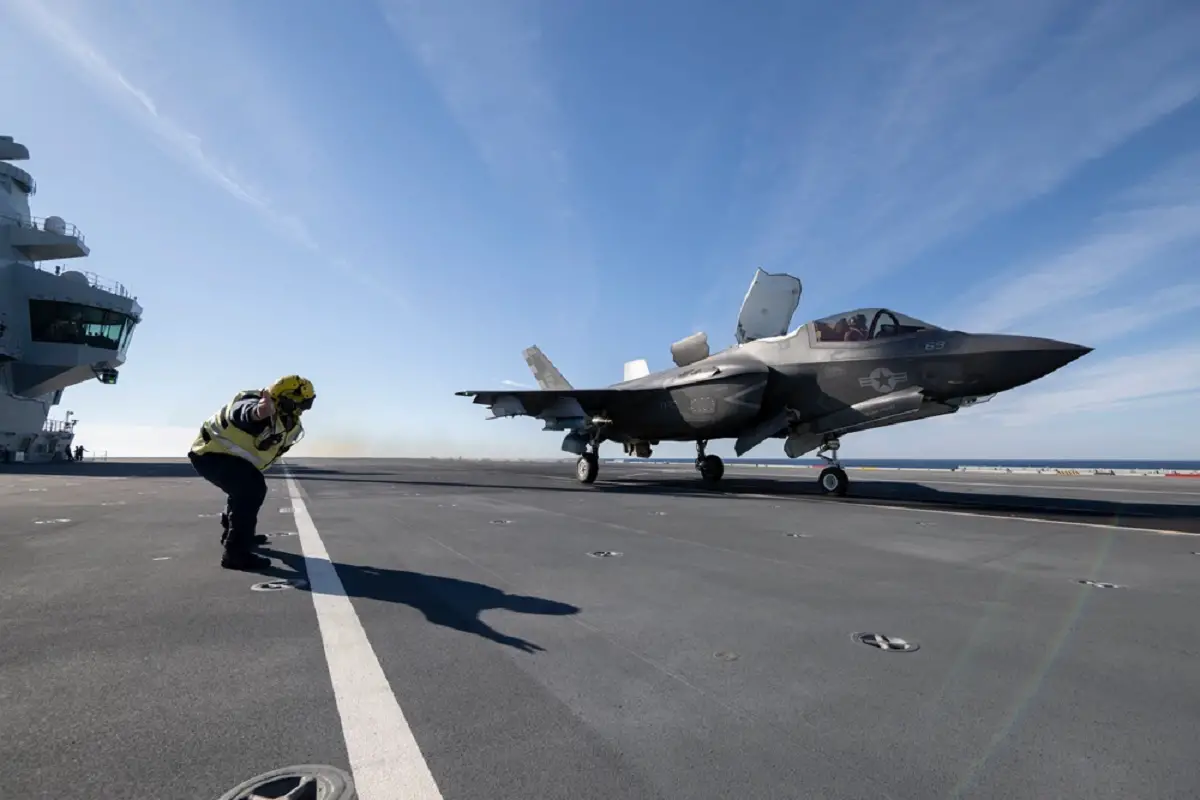A third phase of F-35 Lightning II developmental test (DT-3) flight trials aboard U.K. Queen Elizabeth-class aircraft carriers concluded over the weekend when two short takeoff vertical landing (STOVL) test jets launched from the HMS Prince of Wales (R09) ski jump following almost four weeks of flight test off the Eastern Seaboard of the United States. A Patuxent River F-35 Integrated Test Force (PAX ITF) detachment and two F-35Bs completed DT-1 and DT-2 aboard HMS Queen Elizabeth (R08) in 2018. These sea trials happened during the ship’s ongoing autumn deployment to the Western Atlantic for WESTLANT 23, which encompasses a range of U.K. and U.S. naval aircraft trials. The flight test on HMS Prince of Wales, Britain’s biggest warship, was conducted to gather data that will inform recommendations that could result in increased operational capability for the 65,000-tonne ship, for QEC carriers, and for the 5th generation joint strike fighter aircraft.
During October and early November, three test pilots flying two specially instrumented F-35B aircraft performed close to 150 short takeoffs (STOs), approximately four score vertical landings (VLs), and almost 60 shipborne rolling vertical landings (SRVLs), while PAX ITF flight test engineers collected data, compared it to models, and made initial analyses. A key ally, the U.K. is the only top-partner of the seven international partners in the F-35 Joint Strike Fighter (JSF) program. The other six are Italy, the Netherlands, Canada, Australia, Denmark, and Norway. Additionally, there are currently nine foreign military sales customers. The ship’s lead planner, who worked extensively with the PAX ITF during the preparations, onload, and execution of the flight trials, and whose air engineers worked hand-in-glove with the embarked test team shared his perspective. One pilot who flew test missions during the sea trials shared why the experience was a memorable one to him.
“The integration of our teams to realize approximately 150 test points of the F-35B program will potentially increase the way the U.K can operate the F-35. SRVL, night SRVL, and heavy load (bombs) test points yielded data that will inform any future decisions about the possible F-35B operational clearance to take off and land heavier, operate in heavier sea states, and turn the jets around faster for more sorties,” said Royal Navy Lt. Cdr. Jamie Elliott, Air Engineering Department Head. “.”
“The last four weeks at sea have been the busiest HMS Prince of Wales has ever seen. Watching the F-35B perform the first ever night SRVL was amazing and a real testament to the integration of the F-35 team and my ship’s company. The test points achieved will not only improve U.K. F-35B operations, but those of our F-35B program partners and allies as well,” said Royal Navy Capt. Richard Hewitt, the ship’s commanding officer.

“It was an excellent opportunity to have the privilege to fly aboard HMS Prince of Wales and participate in flight trials designed to contribute to pushing the boundaries of 21st century aircraft carrier operations. Witnessing firsthand the interoperability of the F-35 and the carrier in taxing conditions ranging from high deck motion to high winds over deck, and from maximum weight launches to night operations will be a lasting memory credited to the dedicated men and women embarked for this trial,” said Marine Maj. Alex Horne, F-35 test pilot, PAX ITF.
“Through detailed planning, diligent preparation, and working closely together with the HMS Prince of Wales’ crew, we achieved highly successful flight test during this detachment. We were honored to conduct these sea trials with our F-35 program Level I partner as we worked together to deliver additional warfighting capability. I was proud of how the ITF team—maintainers to pilots, engineers to logisticians, and security to information technology to detachment integrators—collectively performed from day one. Team members recognized the value of our mission, appreciated the importance of this detachment, and committed to the hard work to ensure we accomplished safe, secure, and efficient flight test aboard the U.K.’s newest aircraft carrier,” said Andrew Maack, Pax River F-35 ITF chief test engineer, who was embarked during the flight trials.
Before the first test point was achieved, much communication and coordination went into crafting a comprehensive test plan and concept of operations, and readying everyone and the equipment. Engineers in disciplines like flying qualities, utilities and subsystems, mission systems, propulsion, as well as flight test operations were part of the approximately 180-person team detached from the PAX ITF. The carrier is currently alongside in Norfolk, Virginia, where it offloaded the PAX ITF team and their equipment. The Portsmouth-based ship and her crew head back to sea soon to conduct further aviation trials before heading back across the Atlantic to England’s south coast.












